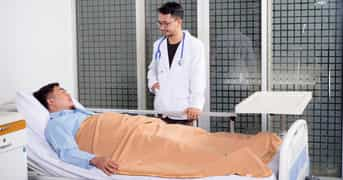The Internet of Things in Healthcare: How Has it Changed and What Does the Future Look Like?
3 minute read | 19/12/2019
If you’re not familiar with the Internet of Things (IoT) then, broadly speaking, it’s a term that refers to everything that’s connected to the internet. These days, that includes everything from smart energy meters to wearable devices like FitBits.
In the healthcare world, IoT covers medical devices that connect to IT systems and share valuable data. This is often referred to as the Internet of Medical Things (IoMT). Here’s how the IoMT is changing patient care and why it’s so important that Trusts embrace recent innovations.
The Impact That the IoT is Having on Healthcare
Technology is completely transforming the way that patients are treated. In many instances, key decisions and diagnoses can be made from the comfort of the patient’s own home.
Imagine a patient who has a preexisting condition. They’ve previously had regular hospital appointments and treatments to combat the symptoms they have to deal with as a result of their condition. A sudden increase in heart rate or blood pressure could signify that they’re about to have a medical episode. Fortunately, they have a small device implanted in their body that’s constantly monitoring key vital signs.
If these numbers start to show signs of a problem, then an alert can automatically be sent to the smartphones of both the patient and their doctor. A quick phone call can identify whether there’s a serious issue or not - without the patient having to leave the comfort of their own home.
This is just one example of the possibilities for the healthcare sector when it embraces the IoMT. These innovations are starting to appear more frequently, especially in the United States, although UK Trusts are also looking to technology to resolve some of the challenges the NHS is currently facing.
Innovations are designed, tested and implemented within the healthcare sector constantly. Although some changes seem to take place slowly, there’s a good chance that by the time this blog is six months old, the IoMT in healthcare will have further transformed patient care.
The Benefits of IoMT in the Future
The real-time alerts mentioned in the above example is just one of the benefits that IoMT will bring to the healthcare industry. They have the potential to save the lives of someone experiencing heart failure or a serious asthma attack.
IoMT will be especially useful when it comes to collating valuable data about patients. Both wearable devices and implanted chips can monitor data over long periods of time. This information can then be used for vital research purposes.
Collating this data manually would take years and patients often don’t want the hassle of hospital visits for this purpose. In addition to saving time, this method of data collection is cheaper too. IoMT in healthcare gives researchers the crucial information they need to work on life-saving treatments that are so desperately needed.
It isn’t just treatments that are seeing the benefits of IoMT in healthcare. A huge part of a patient’s experience is affected by the entertainment system they have access to while they’re treated.
When the existing systems that are in place were introduced, they were a huge improvement on the facilities that were available before. Now, however, they’re limited, awkward and often leave patients with significant bills if they want to watch television.
There are new and innovative alternatives available that have completely transformed patient entertainment systems. They utilise patient smartphone devices and remove the need for bulky equipment that’s currently in place.
The new systems do more than just television. With the right engagement platform, they can be used to offer educational content to patients by clinical staff. A patient who might be suffering from smoking-related health problems can receive free anti-smoking reading material to help them quit.
One of the biggest issues that new patient systems can resolve is food wastage caused by an inefficient meal ordering process.
Patients can make their choice via the system and find a meal that suits their specific dietary requirements. They can also choose to refuse a meal if their medical circumstances mean they can’t eat or if they’re being discharged that day.
This eliminates the need for a member of staff to carry out this process manually. The right meal finds the right patient and less food is wasted as a result.
Improvements to patient entertainment systems are just one innovation we expect to be more prevalent in the future. When Trusts embrace these changes and the wider IoMT, patients receive better care and staff find it easier to carry out their tasks.
Considering A New and Improved Patient Engagement System?
Check out SPARK Fusion.
About the author
Rebecca O'Donovan
Becky is the Marketing Director at SPARK TSL, of whom she has worked for since 2012. She is responsible for high-level marketing strategy focusing on lead generation and aiding the vision of the business to ensure business growth.
More articles by the author
Related articles
 Healthcare Industry
Healthcare Industry
Improve Workforce Efficiencies in Healthcare to Enhance Patient Care
There’s no doubt the current pandemic overwhelmed health systems and exposed limitations in delivering care. ...
 Healthcare Industry
Healthcare Industry
Why is Service Improvement Important in the NHS?
One of the NHS’ biggest and most important challenges is improving the quality of care for its patients. Even ...
 Healthcare Industry
Healthcare Industry
The Importance of Patient TV Systems in 2019 | SPARK TSL
Patient TV systems are more important than ever in 2019. Hospitals and other healthcare facilities that have ...


